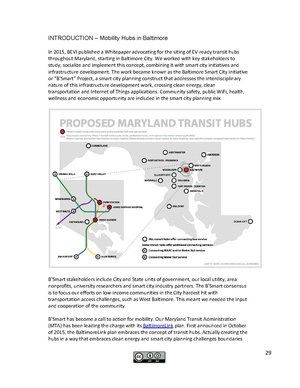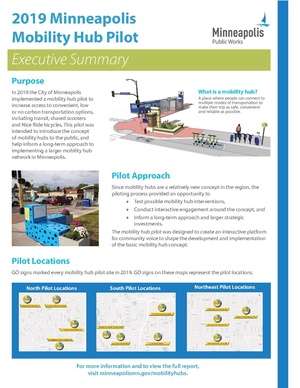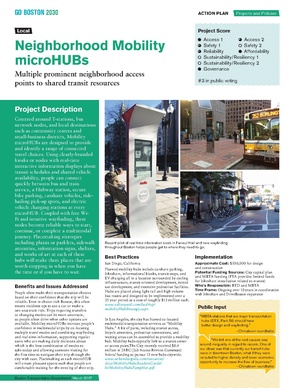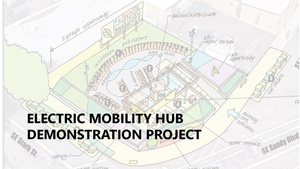|
|
| Line 29: |
Line 29: |
| reducing shipping and logistics costs. | | reducing shipping and logistics costs. |
|
| |
|
| [[File:Transit Hubs.pdf|300px|EV-Ready Transit Hubs White Paper]] [[File:wcmsp-224821.pdf|300px|2020 Minneapolis Mobility Hubs Summary]] [[File:neighborhood_mobility_microhubs.pdf|300px|Neighborhood Mobility Microhubs]] | | [[File:Transit Hubs.pdf|300px|EV-Ready Transit Hubs White Paper]] [[File:wcmsp-224821.pdf|300px|2020 Minneapolis Mobility Hubs Summary]] [[File:neighborhood_mobility_microhubs.pdf|300px|Neighborhood Mobility Microhubs]] [[File:PGE mobility hub - Most Recent.pdf|300px|PGE Electric Mobility Hub Demonstration Project]] |
Revision as of 06:09, January 13, 2022
| Transportation
|

|
|
|
| Sectors |
Utility
Transportation
|
| Contact |
Wilfred Pinfold
|
| Topics |
|
Activities

|
|
Boring Company Las Vegas Convention Center Loop
|
| The LVCC Loop system — a three-station transportation system consisting of 1.7 miles of tunnel — was built in approximately one year (using the now-legacy Godot Tunnel Boring Machine). LVCC Loop's cost was approximately $47M (firm fixed pricing) for the two tunnels and three stations (two surface and one subsurface). Tunneling occurred during large conventions (>100,000 attendees pre-COVID) with zero road closures and zero attendee disturbances.
|
|
|

|
|
City of Boston GoHubs
|
A majority of our residents rely upon public transit, biking, walking, and driving to get around our city. But, shared mobility and technology advances are altering travel.
New ways of transportation are introduced each day. The future of transportation may very well be shared, electric, and highly mobile.
GoHubs! are intended to help us organize these modes. We provide information on how to access them and navigate the technology, and ultimately make it easier to get around Boston
|
|
|

|
|
Electric Mobility Hub Demonstration
|
| An inviting & equitable community space that showcases electric mobility, integrates the street to the neighborhood, and serves as a model for future hubs.
|
|
|

|
|
Minneapolis Mobility Hubs
|
| In 2019, the City of Minneapolis launched a mobility hub pilot program to increase access to convenient, low or no carbon transportation options, including transit, shared scooters and Nice Ride bicycles.
|
|
|

|
|
Smart Transit Hubs - B Smart
|
Pilot a smart street light corridor within a system of transit “super-nodes” developed by transforming current major transit stations into transit hubs (Hubs) defined by:
- connected, city-wide mobile resources; public wifi
- last mile, multi-modal transport between and to/from Hubs (car share, bike share, ride share, preferably electric vehicles with EV-charging at Hub)
- GPS / GIS / location services
- Bus rapid transit, preferably electric, running non-stop Hub to Hub
|
|
|

|
|
Smart and Accessible Transportation Hub
|
| This GCTC Team aims to systematically investigate a novel cyber-physical infrastructure framework that can effectively and efficiently transform existing transportation hubs into smart facilities. The Smart Hub is capable of providing better location-awareness services (e.g. finding terminals, improving travel experience, obtaining security alters) to the traveling public, especially for the underserved populations including those with visual impairment, Autism Spectrum Disorder (ASD), or simply navigation challenges.
|
|
|
Press

|
|
BP approved to deliver the Aberdeen Hydrogen Hub
|
| An international energy company has been approved to be the Joint Venture partner to deliver the ambitious Aberdeen Hydrogen Hub which will build a solar power facility connected to a green hydrogen production and refuelling facility.
|
|
|
|
- Authors












{{{summary}}}
Any transit stop can be turned into a Mobility hub where the first and last mile vehicles are serviced, charged and stored when not in service. At these
hubs passenger experience can be improved with digital information signs that respond to real-time conditions, improved lighting, improved pedestrian
safety, bike racks, improved safety including CCTV cameras, and much more.
Using technology to increase safety and security at transportation hubs improves ridership and reduces cost. Transit hubs can become business hubs where
people stop for food and coffee, to pick up and drop off packages, and to do some local shopping on their way to and from work. Attachment A of this
document offers an “EV-Ready Transit Hubs White Paper” exploring this topic in more detail.
Electric Vehicle Charging Infrastructure
We plan to work with Forth Mobility on demonstration projects to advance electric, smart and shared transportation. We plan to work with Portland General
Electric Company (PGE) and their efforts to accelerate transportation electrification.
Maintenance and System Operation
Urban Speed Electric Vehicles like Mobility Cubed’s World Bus are constructed with less than 300 major parts, compared to over 2,500 parts for a typical
gasoline engine vehicle. In addition, these vehicle’s assembly techniques are significantly less complicated than typical gasoline engine vehicles.
The small bill of materials coupled with streamlined assembly processes enable Mobility Cubed to deploy relatively small (5,000 unit) volume runs of
vehicles. The vehicles can be assembled and maintained at facilities near their operation, thereby providing local jobs, supporting the local economy,
reducing shipping and logistics costs.



























